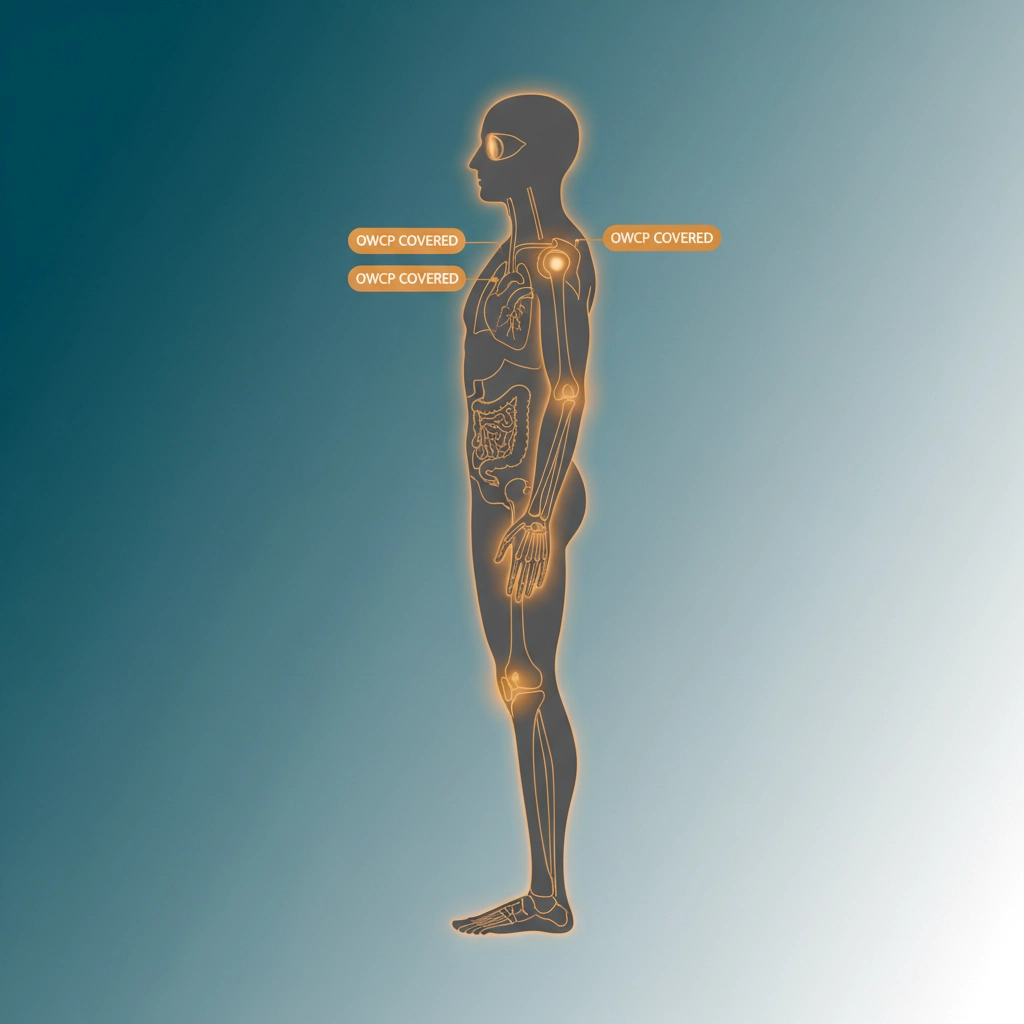IMPORTANT NOTICE: This article is for informational purposes only and does not constitute legal or medical advice. Federal employees must consult with qualified professionals for specific guidance regarding their individual circumstances.
Federal employees who suffer workplace injuries may be entitled to compensation beyond standard wage replacement benefits. OWCP Scheduled Awards represent a specific category of workers’ compensation that provides monetary compensation for permanent impairments to designated body parts. Understanding these awards is essential for maximizing your benefits and ensuring proper compensation for work-related injuries.
WARNING: The information contained in this article does not replace professional consultation. It is very important to do your own research and seek independent professional guidance before making any decisions regarding OWCP claims.
What Are OWCP Scheduled Awards?
OWCP Scheduled Awards are lump-sum monetary payments made to federal employees who have sustained permanent impairment or loss of function to specific body parts as a result of work-related injuries. These awards are governed by the Federal Employees’ Compensation Act (FECA) and are administered by the Office of Workers’ Compensation Programs (OWCP).
The awards differ fundamentally from wage-loss compensation in that they provide compensation specifically for the permanent impairment itself, regardless of whether the employee experiences actual wage loss. These benefits recognize that certain injuries result in permanent diminished function that warrants separate compensation.
COMPLIANCE NOTICE: Scheduled awards are generally not payable concurrently with wage-loss compensation benefits, but may be paid alongside regular wages or retirement benefits under specific circumstances.

Eligibility Requirements for Scheduled Awards
Federal employees must meet specific criteria to qualify for scheduled awards. These requirements are strictly enforced and must be documented with appropriate medical evidence.
Primary Eligibility Criteria
Accepted OWCP Claim: The underlying workers’ compensation claim must be formally accepted by OWCP. Without an approved claim, no scheduled award benefits are available.
Maximum Medical Improvement (MMI): The employee must reach a medical plateau where further improvement is not expected, even with continued treatment. Only qualified physicians can make this determination based on objective medical evidence.
Permanent Impairment: There must be measurable, permanent loss of function or impairment to a body part specifically listed on the OWCP schedule.
Medical Documentation: All impairments must be supported by comprehensive medical documentation and formal impairment ratings conducted according to American Medical Association guidelines.
Qualifying Body Parts Under the Schedule
The OWCP maintains a definitive list of body parts eligible for scheduled awards. This list is comprehensive but specific, and injuries not covered by the schedule are ineligible for these particular benefits.
Covered Extremities and Body Parts
The following body parts qualify for scheduled awards:
- Upper Extremities: Arm, hand, finger
- Lower Extremities: Leg, foot, toe
- Sensory Organs: Eye, ear
- Internal Organs: Lung, kidney
- Reproductive Organs: Breast, cervix, ovary, penis, testicle, uterus, vagina, vulva
- Other Covered Parts: Larynx, skin, throat, tongue
IMPORTANT LIMITATION: Spinal injuries (cervical, thoracic, lumbar) are NOT covered under the schedule unless they result in documented impairment to covered extremities. Back injuries alone do not qualify for scheduled awards.

Calculation Methods for Scheduled Awards
The monetary value of scheduled awards is determined through a specific mathematical formula that incorporates three primary factors. Understanding this calculation is essential for estimating potential benefits.
Calculation Formula
Schedule Award Payment = (OWCP Compensation Rate) × (Weeks Assigned to Body Part) × (Impairment Percentage)
OWCP Compensation Rates
- 66⅔% of regular pay: For employees with no dependents
- 75% of regular pay: For employees with one or more dependents
Weekly Allocations by Body Part
Each qualifying body part has a predetermined number of weeks assigned for calculation purposes:
- Arm: 312 weeks
- Hand: 244 weeks
- Finger (various): 46-75 weeks depending on specific digit
- Leg: 312 weeks
- Foot: 205 weeks
- Eye: 160 weeks
- Hearing (both ears): 200 weeks
Practical Calculation Example
Conservative Example:
- Federal employee with dependents earning $60,000 annually
- 15% permanent impairment to dominant hand
- Calculation: ($45,000 × 75%) × (244 weeks × 15%) × (1/52 weeks per year)
- Estimated Award: $2,377
Moderate Example:
- Federal employee with dependents earning $80,000 annually
- 25% permanent impairment to arm
- Calculation: ($60,000 × 75%) × (312 weeks × 25%) × (1/52 weeks per year)
- Estimated Award: $5,385
DO YOUR OWN RESEARCH: These examples are for illustrative purposes only. Actual awards depend on specific circumstances, current pay rates, and precise impairment ratings.
Application Process and Required Documentation
The process for obtaining scheduled awards requires systematic completion of specific steps and submission of detailed documentation. Failure to follow proper procedures may result in claim denial or delayed processing.
Step-by-Step Application Process
Step 1: Obtain Accepted OWCP Claim
Ensure your underlying workers’ compensation claim has been formally accepted by OWCP.
Step 2: Complete Medical Treatment
Continue all prescribed medical treatment until reaching Maximum Medical Improvement as determined by your treating physician.
Step 3: Secure Impairment Rating
Obtain a formal impairment rating from a qualified physician using the American Medical Association’s Guide to the Evaluation of Permanent Impairment, 6th Edition.
Step 4: Submit Formal Application
Complete Form CA-7 (Claim for Compensation), selecting option “D” for Schedule Award, and submit with supporting medical documentation.
Step 5: Await OWCP Review
OWCP will review all submitted materials and issue a determination on your scheduled award claim.
Critical Documentation Requirements
- Comprehensive Medical Records: Complete treatment history and diagnostic test results
- Impairment Rating Report: Formal evaluation using AMA 6th Edition guidelines
- Physician Narrative: Detailed medical report explaining the permanent nature of the impairment
- Completed Forms: Properly executed CA-7 and any additional required documentation
COMPLIANCE WARNING: All impairment ratings must be conducted using the AMA 6th Edition guidelines. Ratings based on previous editions will be denied.

Maximizing Your Scheduled Award Benefits
Federal employees can take specific actions to optimize their scheduled award benefits while ensuring compliance with all applicable regulations and requirements.
Medical Provider Selection
Choose Experienced Physicians: Select doctors with specific experience in federal workers’ compensation cases and AMA impairment rating procedures.
Verify AMA 6th Edition Training: Confirm that your physician is trained and current on AMA 6th Edition impairment rating methodologies.
Maintain Comprehensive Records: Ensure all medical appointments, treatments, and evaluations are thoroughly documented.
Documentation Strategies
Complete All Prescribed Treatment: Follow all medical recommendations to demonstrate commitment to recovery and establish Maximum Medical Improvement.
Obtain Multiple Opinions: Consider seeking evaluation from multiple qualified physicians to ensure accurate impairment assessment.
Maintain Personal Records: Keep detailed personal records of all medical appointments, treatments, and communications with OWCP.
Common Mistakes and How to Avoid Them
Federal employees frequently encounter preventable obstacles when pursuing scheduled awards. Understanding these common errors can significantly improve claim success rates.
Frequent Application Errors
Using Incorrect AMA Edition: Submitting impairment ratings based on AMA 5th Edition rather than the required 6th Edition results in automatic denial.
Insufficient Medical Documentation: Failing to provide comprehensive medical evidence supporting the permanency of the impairment.
Premature Application: Applying before reaching confirmed Maximum Medical Improvement leads to claim denial.
Incomplete Forms: Submitting partially completed or incorrectly executed application forms delays processing and may result in denial.
Avoidance Strategies
Verify All Requirements: Carefully review all eligibility criteria and documentation requirements before submitting applications.
Professional Consultation: Consider consulting with qualified professionals experienced in federal workers’ compensation matters.
Timeline Management: Allow sufficient time for complete medical evaluation and documentation development.
NO INVESTMENT ADVICE: This information is provided for educational purposes only and does not constitute professional advice regarding specific cases or circumstances.
Professional Consultation and Resources
Given the complexity of OWCP Scheduled Awards and the potential for significant financial impact, federal employees are strongly advised to seek professional guidance for their specific circumstances.
Set a meeting in Benefits Review for comprehensive analysis of your individual situation: https://federalbenefitservice.com/benefits-review/
Professional consultation can provide personalized guidance regarding eligibility assessment, documentation requirements, application strategies, and appeal procedures if necessary.
DISCLAIMER: The content in this article is for informational purposes only and should not be considered as legal, medical, or financial advice. Federal employees must conduct their own research and consult with qualified professionals for guidance specific to their individual circumstances. No liability is assumed for decisions made based on this information.
IMPORTANT NOTICE: It is very important to do your own analysis and seek independent professional guidance before making any decisions regarding OWCP claims or scheduled award applications.



